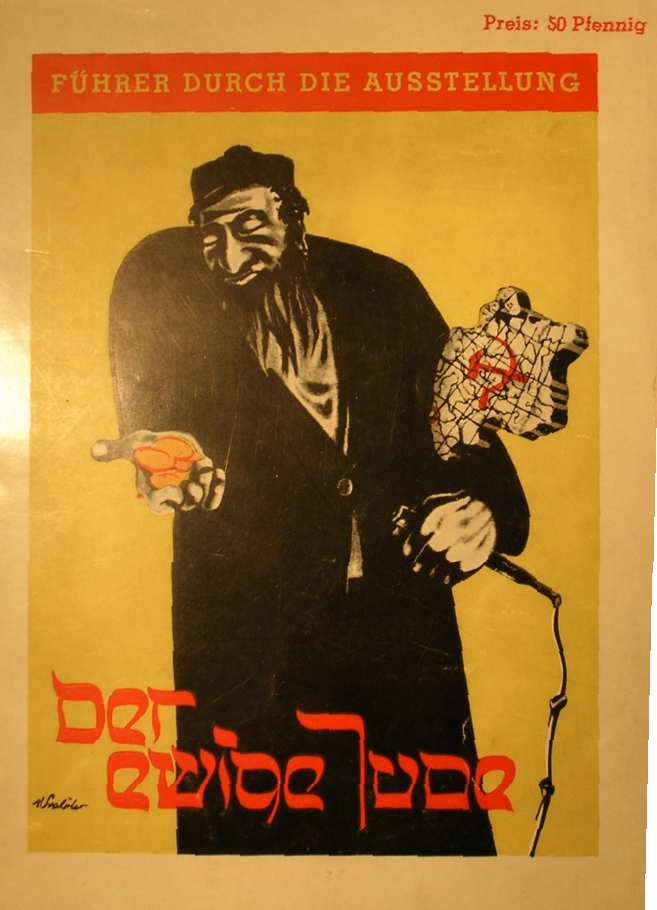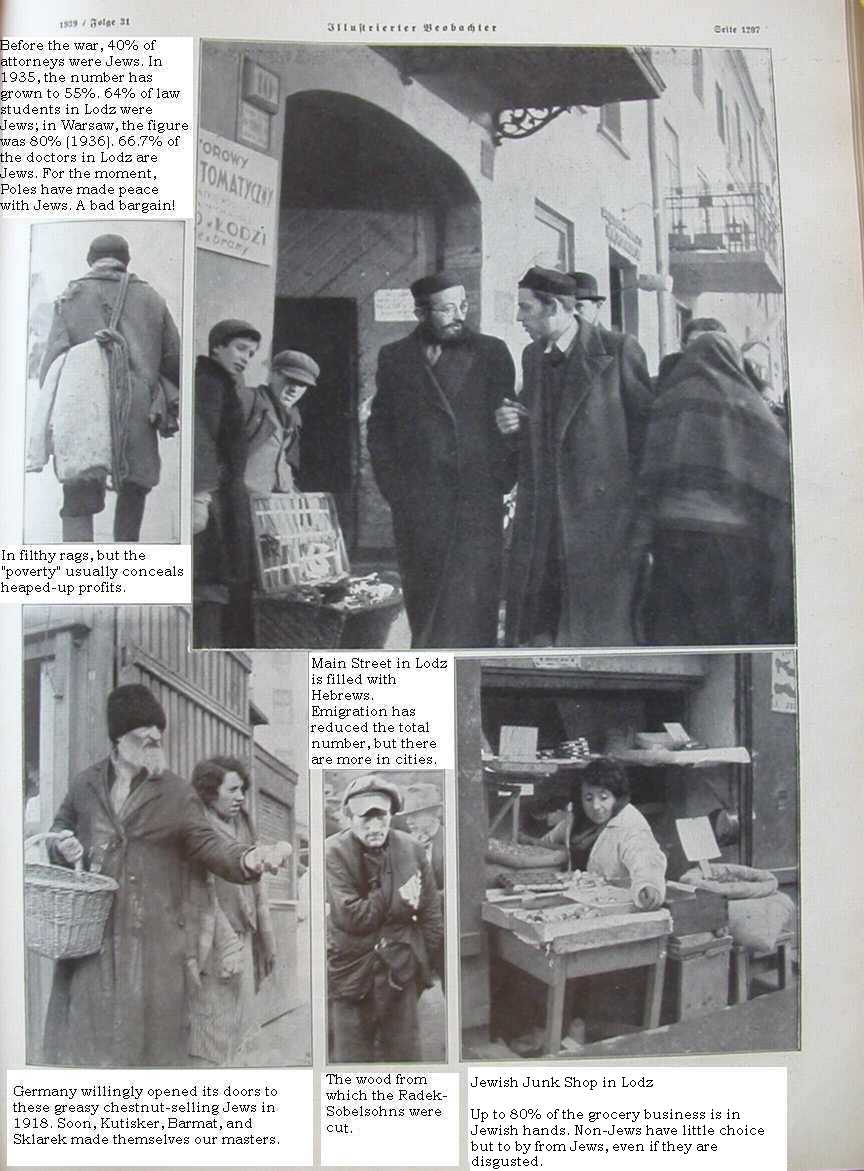Background: These images struck me as vivid and interesting, but did not fit into any particular page on the German Propaganda Archive. I may add more material from these items as time permits.
Miscellaneous Images from the Nazi Era
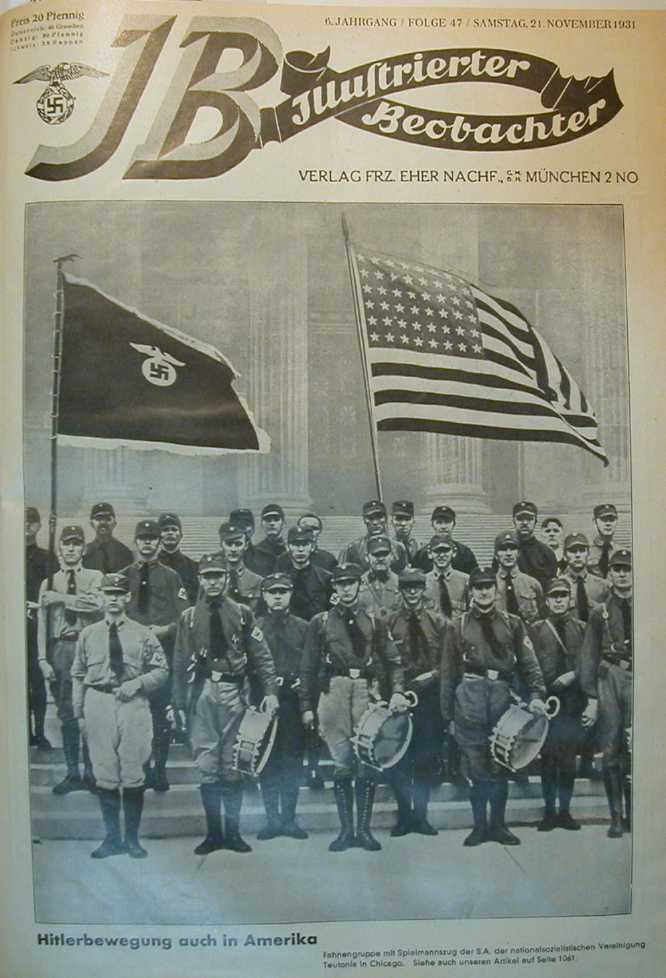
There were Nazis in the United States even before Hitler took power. This is the cover from the Nazi illustrated weekly of 21 November 1931 showing the Chicago band of Nazis. Their flag is their own design, not at all similar to what the Nazis were using in Germany. The interior of the magazine has other photographs of American Nazis in Chicago, Detroit, and New York.
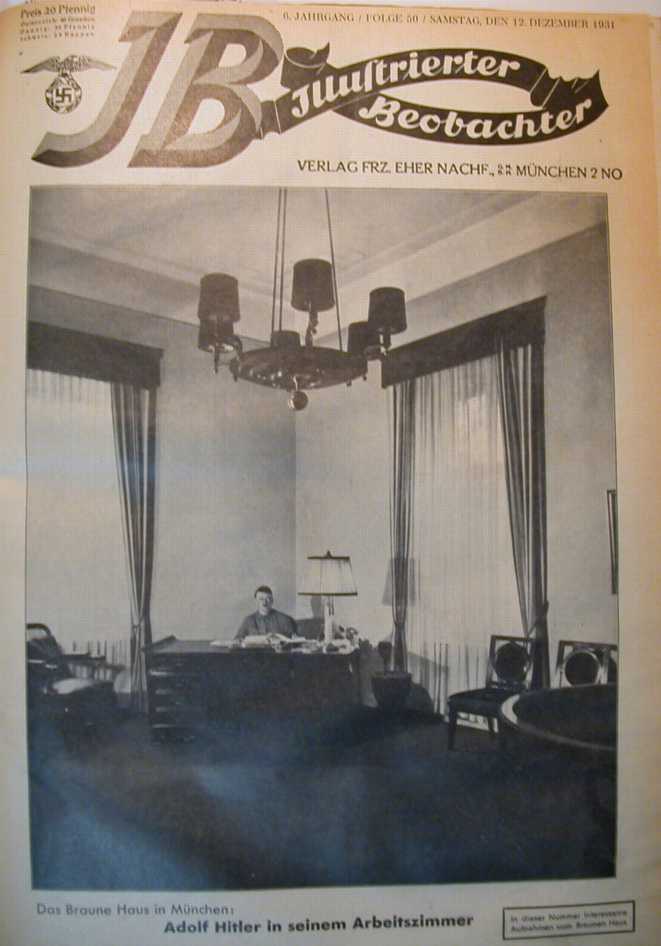
This picture from the Nazi illustrated weekly shows Hitler’s office in the Brown House in Munich in 1931. The Brown House was the party headquarters in Munich, bought with considerable sacrifice on the part of many members. Once in power, Hitler eventually had himself an even more impressive office built in Albert Speer’s Reich Chancellery.
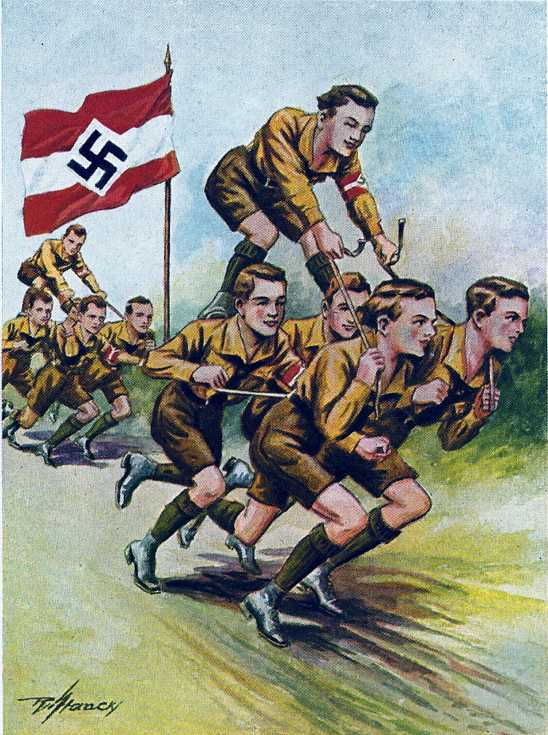
German publishers reacted quickly to new conditions. This is the front illustration to the 1934 edition of a long-running series. The poem accompanying the picture:
What’s this racing up a storm?
The Hitler Youth four-boy race!
Gallop! Gallop! It's the final lap!
Each boy knows:
In games, as in life, the winner is
Only he who keeps going to the end!
Heil Hitler!
Source: Auerbachs Deutscher Kinder-Kalender 1934 (Leipzig: Verlag von Auerbachs Deutschem Kinder-Kalender, 1933).

This is one panel of stained glass windows in a building in the town of Buchholz that commemorated Nazi history. The first four frames have lines from the Horst Wessel Song: “Raise high the Flag! Close the Ranks! / The S.A. is marching with calm and steadfast step / Millions already look to the swastika, full of hope. / The day of freedom and prosperity is near. / Heil Hitler!”
Source: Hans Henningsen, Niedersachsenland, du wurdest unser! Zehn Jahre Nationalsozialismus im Gau Ost-Hannover. Streiflichter aus der Kampfzeit (Hamburg: Niedersachsen-Stürmer Verlag, 1935).
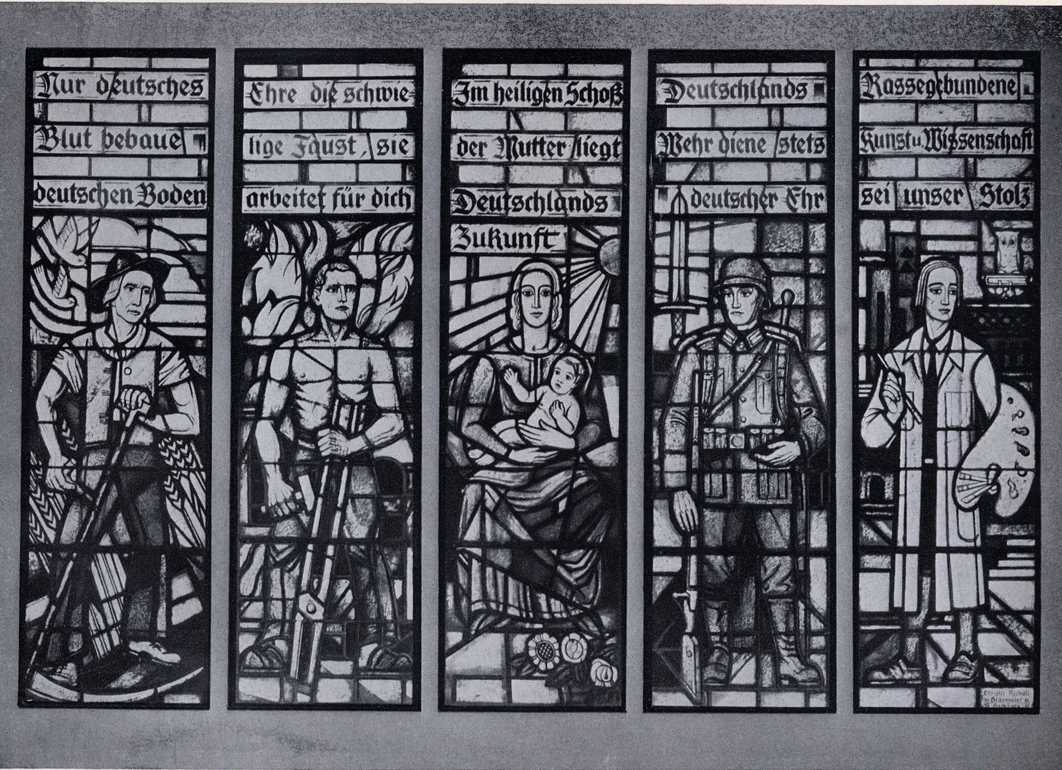
The second stained glass window. The text: “Only German blood may till German soil. / Honor the strong hand, for it works for you. / Germany’s future is in her mothers’ holy wombs. / Germany's army always preserves Germany's honor. / The art and science of our race is our pride.”
Source: Hans Henningsen, Niedersachsenland, du wurdest unser! Zehn Jahre Nationalsozialismus im Gau Ost-Hannover. Streiflichter aus der Kampfzeit (Hamburg: Niedersachsen-Stürmer Verlag, 1935).
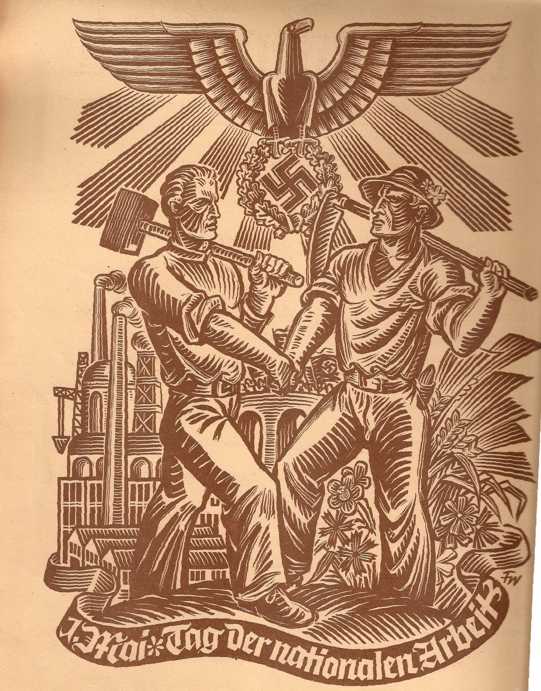
A Nazi graphic for May Day 1936. A factory worker and a farmer join together.
Source: N.S. Frauenwarte, #22 (1935/36).
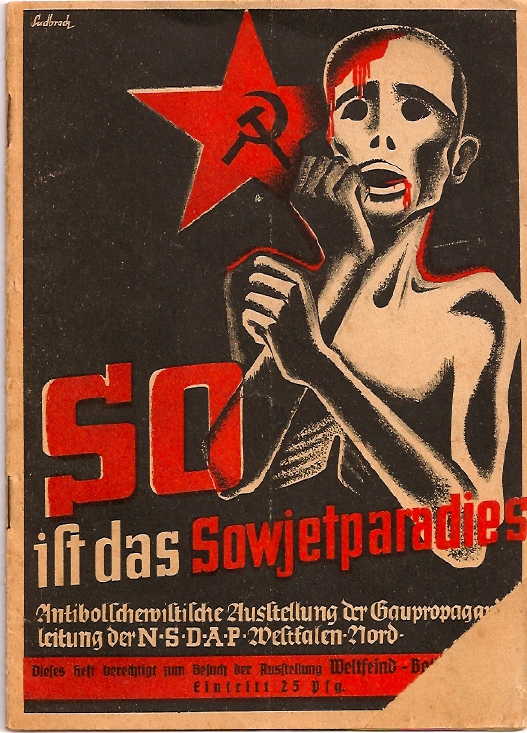
This is the rare program for an exhibit titled: “This is the Soviet Paradise. Anti-Bolshevist Exhibition of Gauleitung Westfalen-Nord.” It is undated, but probably comes from 1937, when the Nazis ran a major anti-Bolshevist campaign.
Source: I took the photo at the Zeitgeschichtliches Forum in Leipzig.
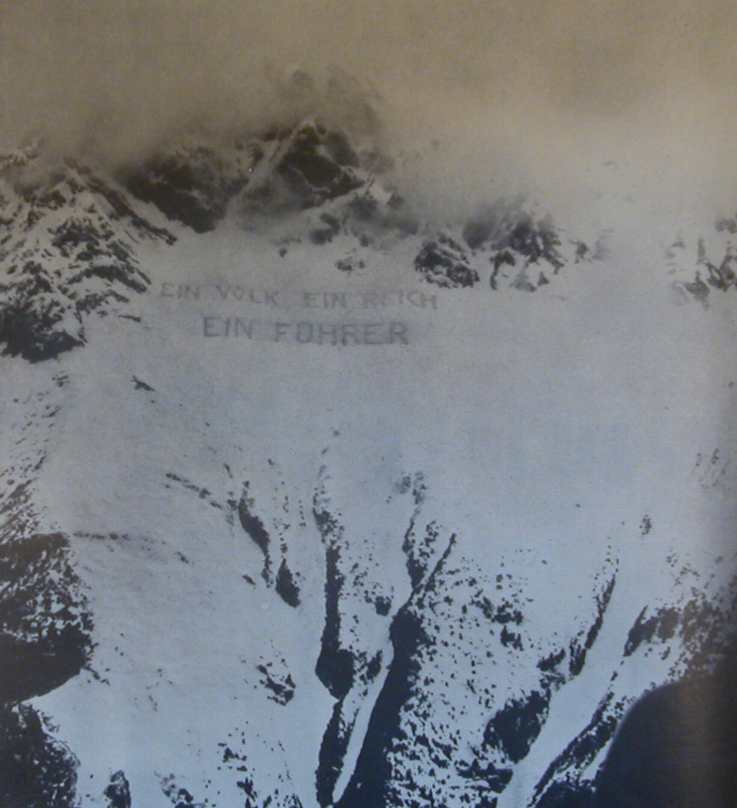
The Nazis took over Austria in March 1938, providing a new arena for propaganda. This picture shows an enormous version of “Ein Volk Ein Reich Ein Führer” [One People One Reich One Führer] carved into the side of the Brandjoch, a peak in the Karwendel range visible from Innsbruck. According to the caption, the words in the snow, put there by local mountain climbers, were almost a mile long.
Source: Illustrierter Beobachter, #15/1938.
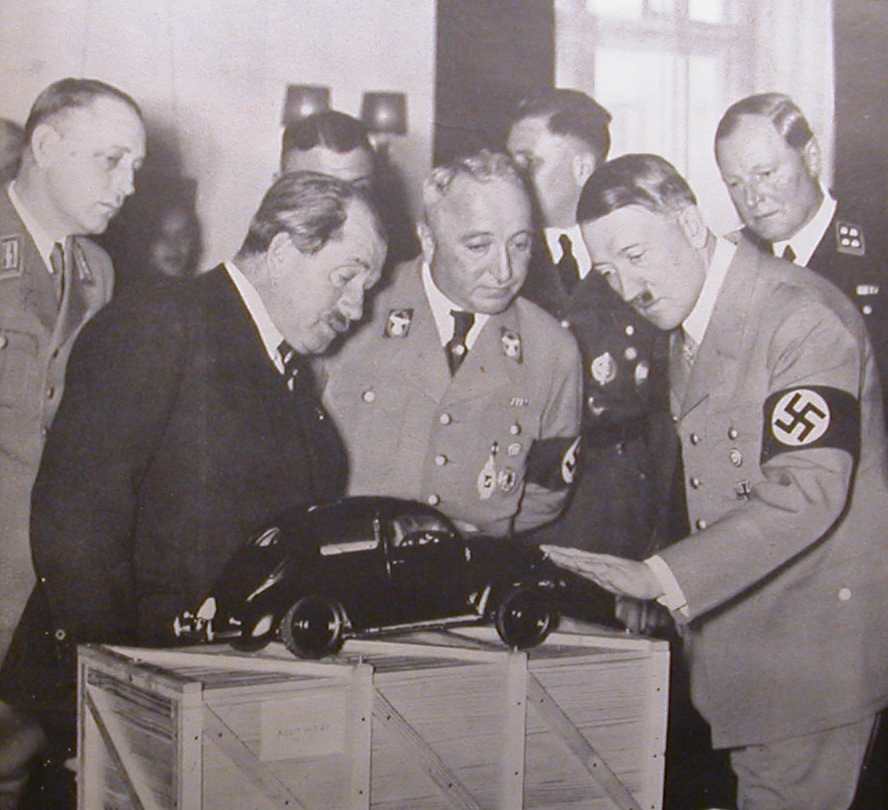
In this picture, Hitler touches one of his birthday presents for the year: a model of the Volkswagen. Next to him are Robert Ley and Ferdinand Porsche.
Source: Illustrierter Beobachter, #17/1938.
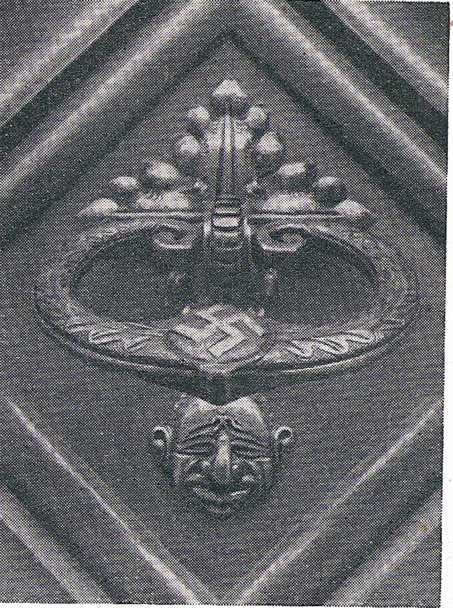
This was the doorknocker for the remodelled city hall in Lauf. The Nazis took particular pleasure in this kind of anti-Semitic item.
Source: Franken-Kalender 1939 (Nuremberg: Verlag Fränkische Tageszeitung, 1938).

Eleanor Roosevelt was a favorite target of Nazi propaganda. In this article, taken from the party's illustrated weekly, she is assailed for her support of Marion Anderson. Promoting a Negro singer, the article claims, insults the healthy racial attitudes of the American public.
Source: Illustrierter Beobachter, #25/1939.
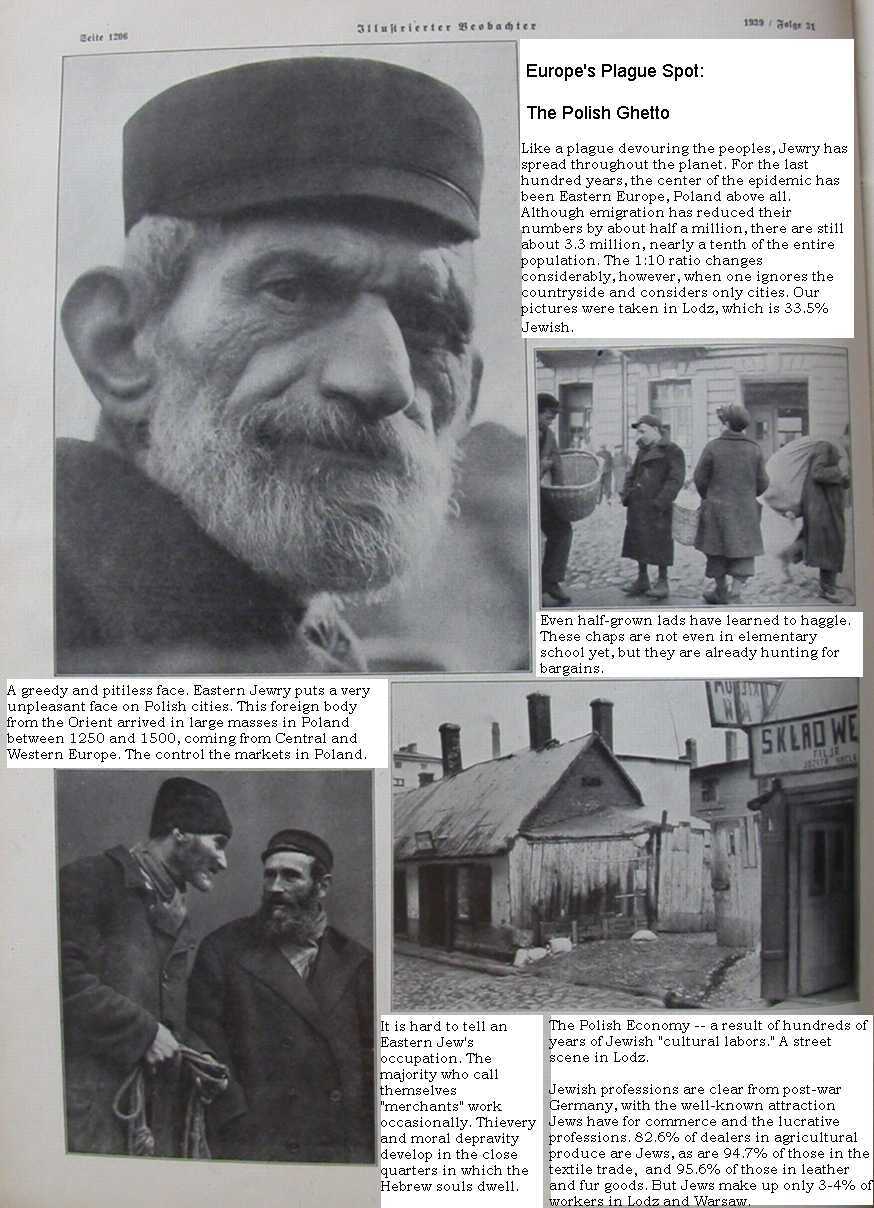
The two-page article, published in early August 1939, just before the Nazi invasion of Poland, presents an unflattering portrait of Jews in Poland. Immediately after the invasion, there were further articles along these lines, culminating in the anti-Semitic film Der ewige Jude, released in 1940.
Source: Illustrierter Beobachter, #31/1939.
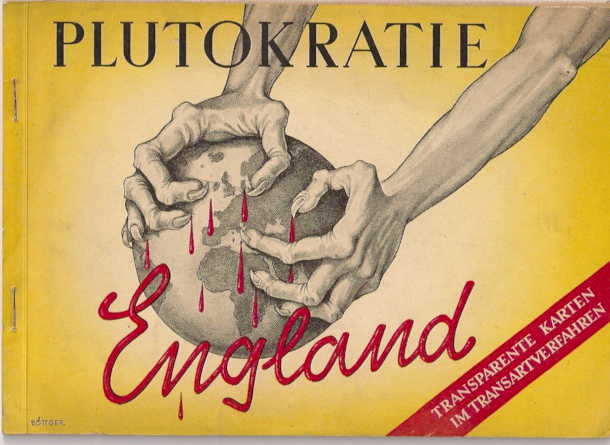
The cover of a summer 1940 pamphlet attacking England. It provides charts of England’s colonial empire over the years, and descriptions of alleged English perfidy.
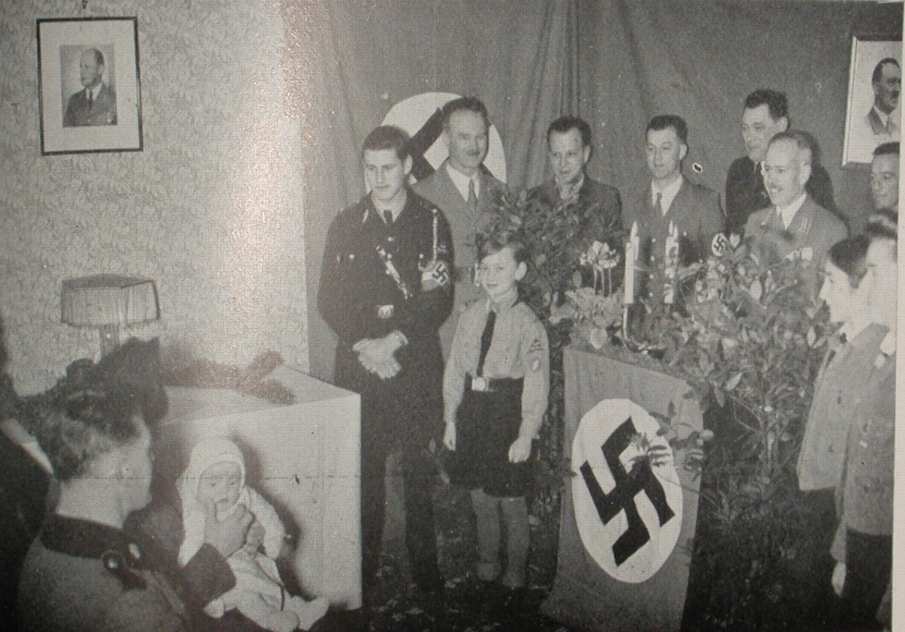
The Nazis wanted to replace Christian rites of baptism, marriage, and death with their own rituals. This picture, from a book intended for Nazi propagandists in Austria, shows a “name giving” ceremony. The text : “A name giving in the parents' home. This is a good, exemplary arrangement within the small circle of the family and comrades. The room is modestly decorated. The ancestor candelabra on the speaker's platform looks very nice, as do the youth who are participating (a Pimpf as speaker, with a BDM choir). The happiness and joy of a name giving is shown very well in this picture.” Note the picture of Hitler to the right.
Source: Lebensfeiern (Linz: NS Gau-Verlag Oberdonau, 1941).
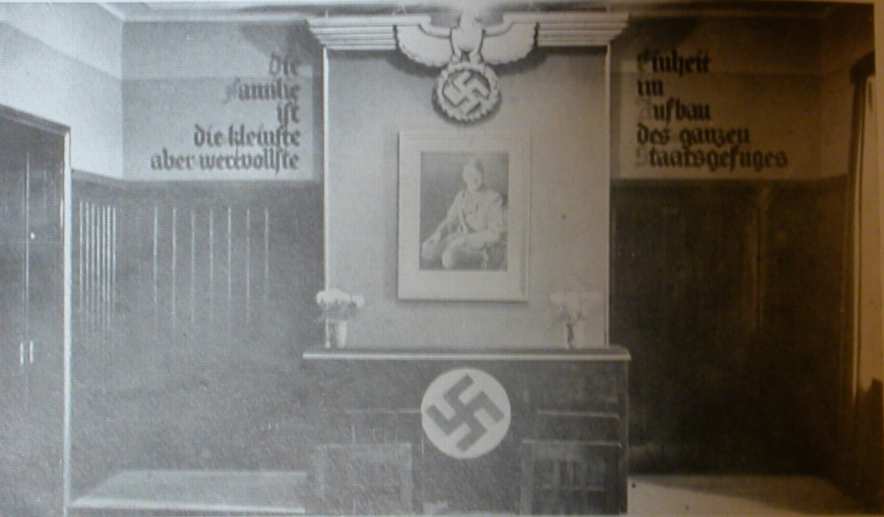
This picture is of the “wedding hall” in the small town of Thalheim (near Wels). The caption: “A lovely and appropriate wedding hall. The quotation on the wall [‘The family is the smallest but most important unit in building the whole state structure.’] is presented in beautiful lettering, which should be done more often when decorating wedding halls. Due to the low ceiling, the placement of the eagle is unsatisfactory. A better solution needs to be found. A small picture of the Führer, or a bust of the Führer on a wooden column, would be better. Beautiful banners could be placed in the corners.”
Source: Lebensfeiern (Linz: NS Gau-Verlag Oberdonau, 1941).

The Nazis did their best to remove any notion of Christ and Christianity from Christmas. This is the 1943 version of a pamphlet intended to help Germans celebrate Christmas in the approved manner. A soldier stands guard in the east, protecting the German homeland. The interior contains stories of war Christmases past and present, pictures of Christmas decorations, etc. The pamphlet was issued by a department of the Reichspropagandaleitung and published by the party’s publishing house.
Source: Deutsche Kriegsweihnacht (Munich: Franz Eher, 1943).
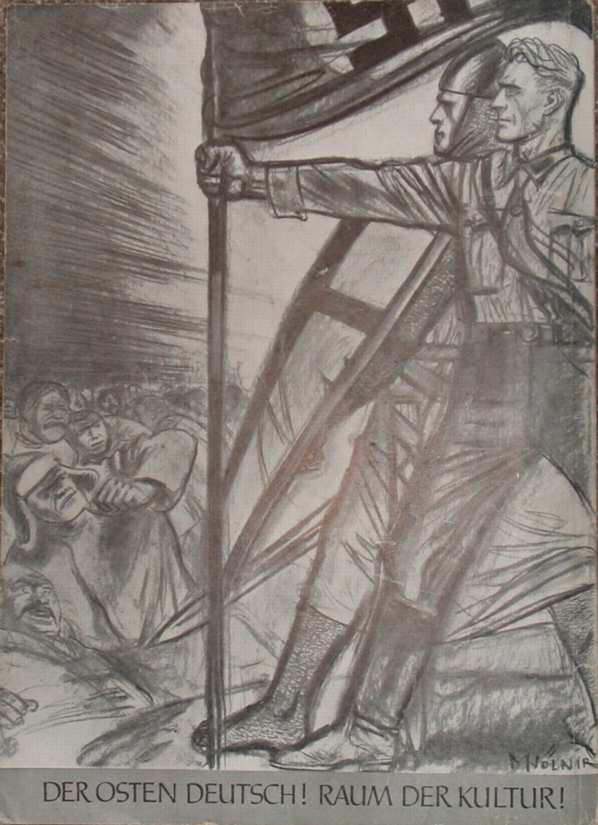
Hans Schweitzer (pen name: Mjlönir) was the quintessential Nazi cartoonist/artist. This 1942 drawing appeared as the tide in Russia was turning against the Nazis. Typical of his style, two large Nazis move forward to confront midget enemies. Der Hoheitsträger was the periodical for Nazi leaders at the Ortsgruppenleiter level and above.
Source: Der Hoheitsträger, November 1942 (back cover).
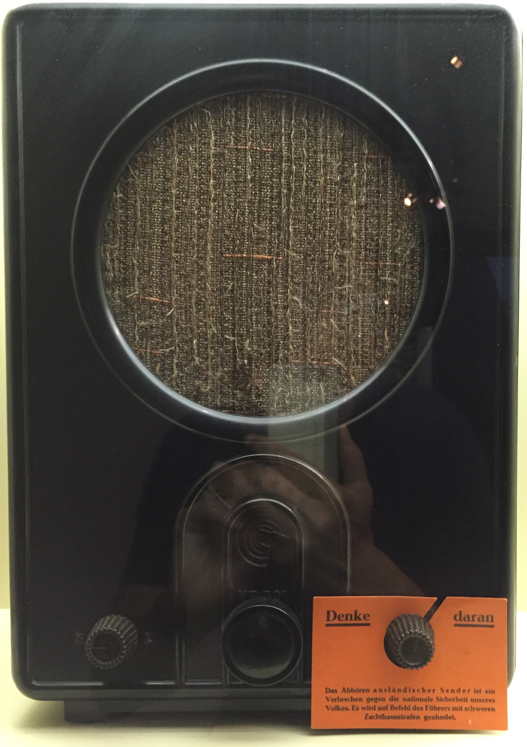
During the war the Nazis grew increasingly worried about people listening to foreign radio broadcasts. Soon people were being imprisoned and even executed if caught listening to the BBC. The tag said: “Think about it. Listening to foreign stations is a crime against our people’s national security. By order of the Führer, it is punished by severe prison sentences.”
To enforce the measure party block leaders and local group leaders (the lowest echelons of the party) were ordered to inspect radios in people’s homes. This was unpopular. In Mecklenburg party officials tried, then sent the difficulties they’d encountered on to the county leadership: “Objections were so strong that the block leaders and local group leaders reported to the county office that it is impossible to do it again.” The document is in the Bundesarchiv, NS 18/988.
Source: I took the photo at the Zeitgeschichtliches Forum in Leipzig.
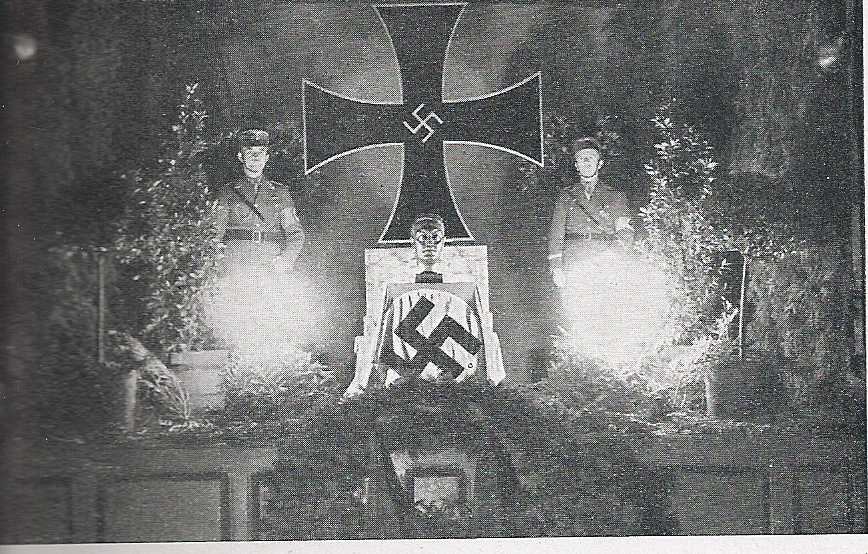
This picture shows what the Nazis thought was a bad example of decorating a stage. The caption translates: “The excessive use of greenery (evergreen branches and wreaths, in circular and pointed form) result is a most unsettling and dark effect. The hidden lighting produces a mysterious, almost mystic mood. Because of the lighting, the bust of the Führer is hardly recognizable as such. Besides that, busts or pictures of the Führer are inappropriate at memorials for the dead. The wreath should not be surrounded by black crepe, but rather by the ribbons of the Party. The Iron Cross is not the way it is in actuality.”
Source: Die neue Gemeinschaft, February 1943.

This striking picture is captioned: “Remembering the fallen husband.” In what is almost an altar, Hitler’s portrait is on the wall above a picture of the woman’s husband, while a candle burns. The two children suggest that, though the man has died, his blood lives on. This picture (the exact date of which I neglected to write down) is from the magazine for party leaders instructing them how to conduct party ceremonies.
Source: Die neue Gemeinschaft, a 1944 issue.




